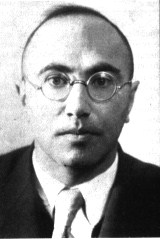





Yakov Borisovich Zel'dovich was born in Minsk, Belorussia (Belarus) on 8 March 1914. At age 17 he began working as a laboratory assistant at the Institute of Physics, the Institute of Chemical Physics, in Leningrad. Zel'dovich was almost entirely self-taught, eventually reaching the level of Academician (the highest rank in Soviet academia) and later becoming professor at Moscow State University without ever received a regular college degree.
Zel'dovich had a remarkably versatile intellect, and during his life explored and made major contributions to a wide range of scientific endeavors. During the 1940s he advanced the state of the science of combustion and detonation. He developed a more sophisticated theory of detonation that accounted for features not previously explained, and correctly predicted features that had not yet been observed. The modern theory of detonation accordingly is called ZND theory (Zel'dovich-von Neumann-Dohring).
In a series of seminal papers written in collaboration with Yuli Khariton in 1939-40, he explored the basic principles of fission chain reactions in both fast and moderated assemblies.
Zel'dovich became the first head of the theoretical department of Arzamas-16, the "Soviet Los Alamos", in 1946. That same year he developed a report with Isaak Gurevich, Isaak Pomeranchuk, and Khariton on the feasibility of releasing energy through nuclear fusion triggered by an atomic explosion and presented it to Igor Kurchatov. This report was published in 1991 in Uspekhi Fizicheskikh Nauk. under the title "Ispol'zovanie iadernoi energii legkikh elementov" ("Utilization of the nuclear energy of light elements").
Zel'dovich led the theoretical work on both the first Soviet atomic and hydrogen bombs. In the course of his work on nuclear weapons, Zel'dovich did ground-breaking work in radiation hydrodynamics, and the physics of matter at high pressure. This research served as the basis for his collaboration with Yuli P. Raizer in writing Physics of Shock Waves and High-Temperature Hydrodynamic Phenomena, a marvelously lucid physics text and by far the best text on radiation hydrodynamics available. Originally published in English in 1966 by Academic Press, it is now (2002) available in a low cost paper back reprint from Dover.
From a focus on particle physics in the 50s, he went on in the later phase of his career he concentrated on astrophysics, becoming head of the division of relativistic astrophysics at the Sternberg Astronomical Institute. Zel'dovich combined astrophysics with his particle physics experience to become a leader in attempts to relate particle physics to cosmology. With Rashid Sunyaev he proposed what is known as the Sunyaev-Zel’dovich effect, an important method for determining the Hubble constant from the effect of gas in galaxy clusters on the microwave background radiation.
He was elected to the Soviet Academy of Sciences in 1958, named laureate of Lenin, and was made a Hero of Socialist Labor (the highest Soviet civilian award) three times. He garnered numerous international awards: he was elected to honorary membership of the National Academy of Sciences, of the Royal Society, and several other national societies. He was the 1983 Bruce Medalist (awarded by the Astronomical Society of the Pacific). Zel'dovich died suddenly on 2 December 1987. See his obituary published in Soviet Astronomical Letters 14, 121-2 (1988).